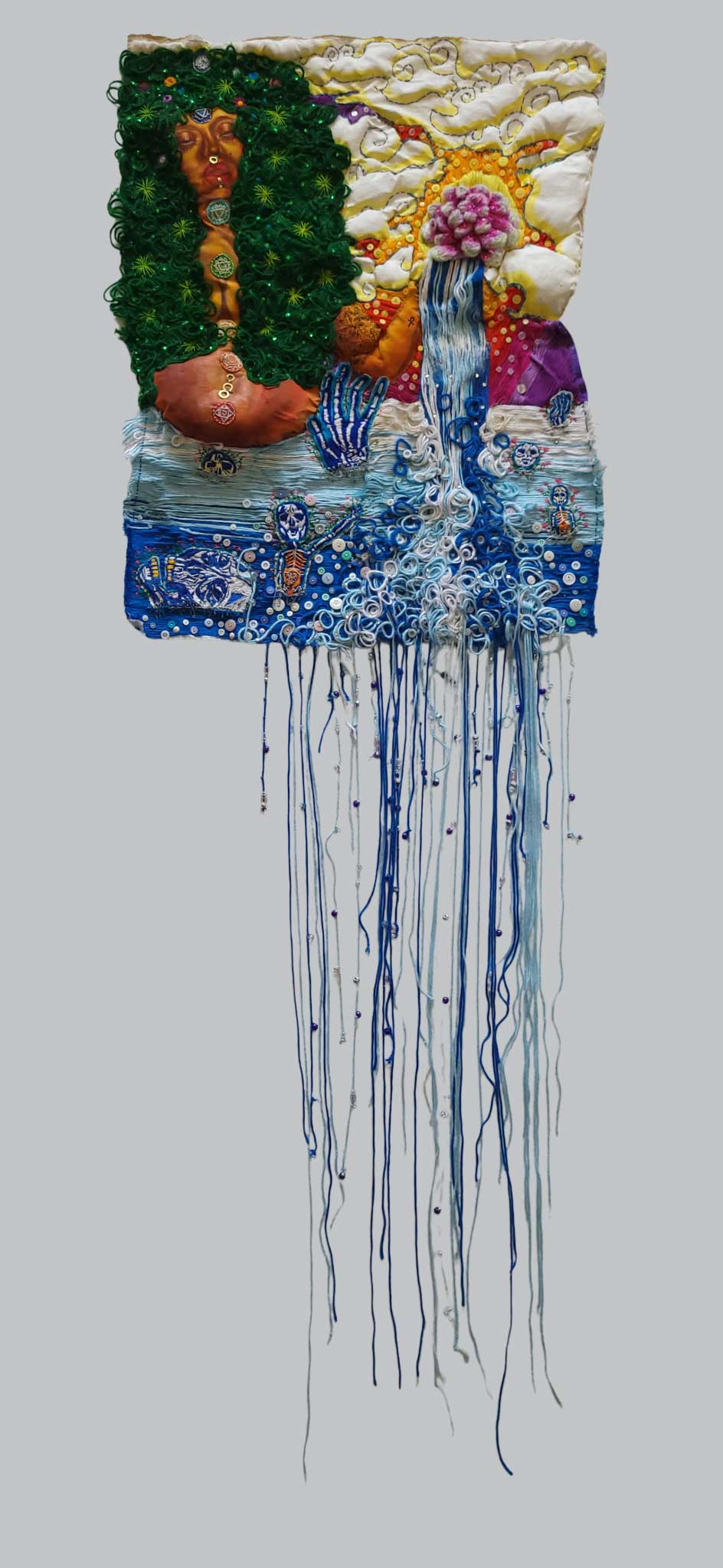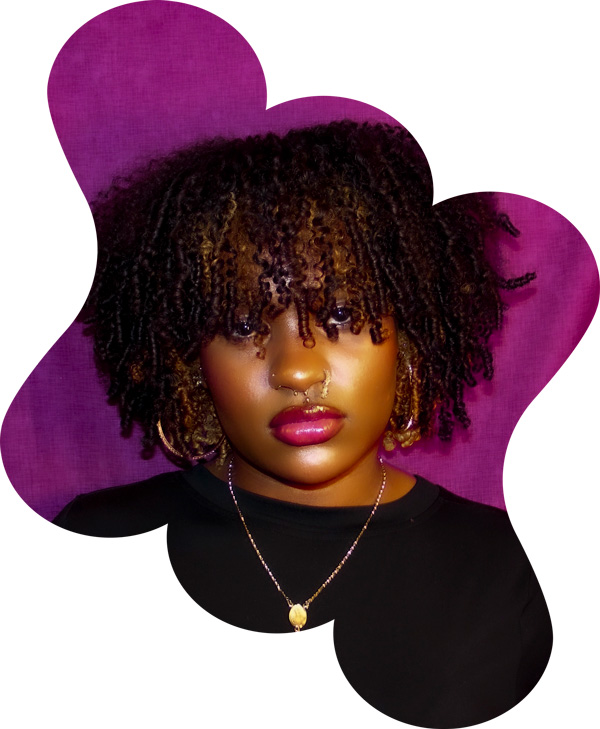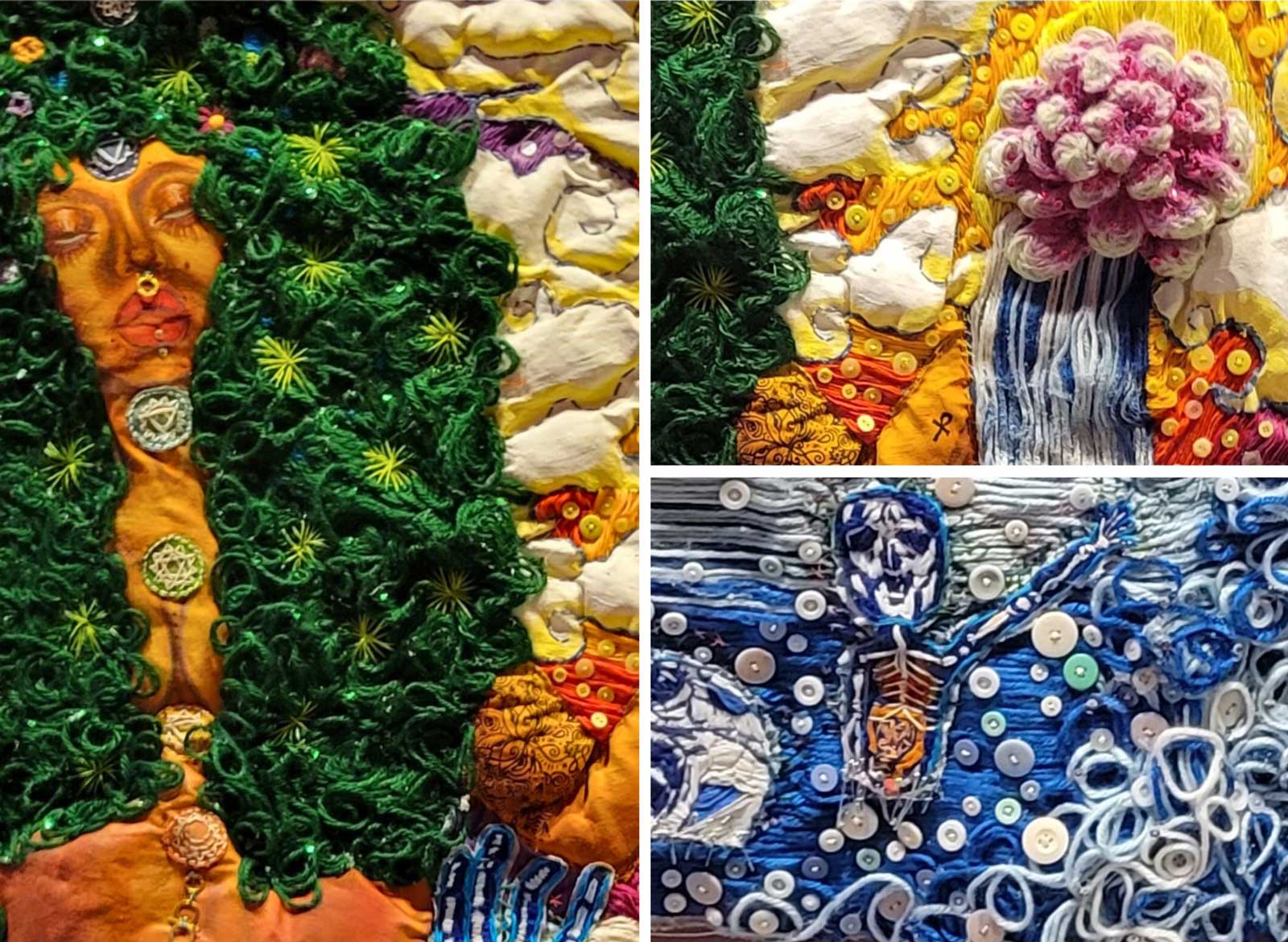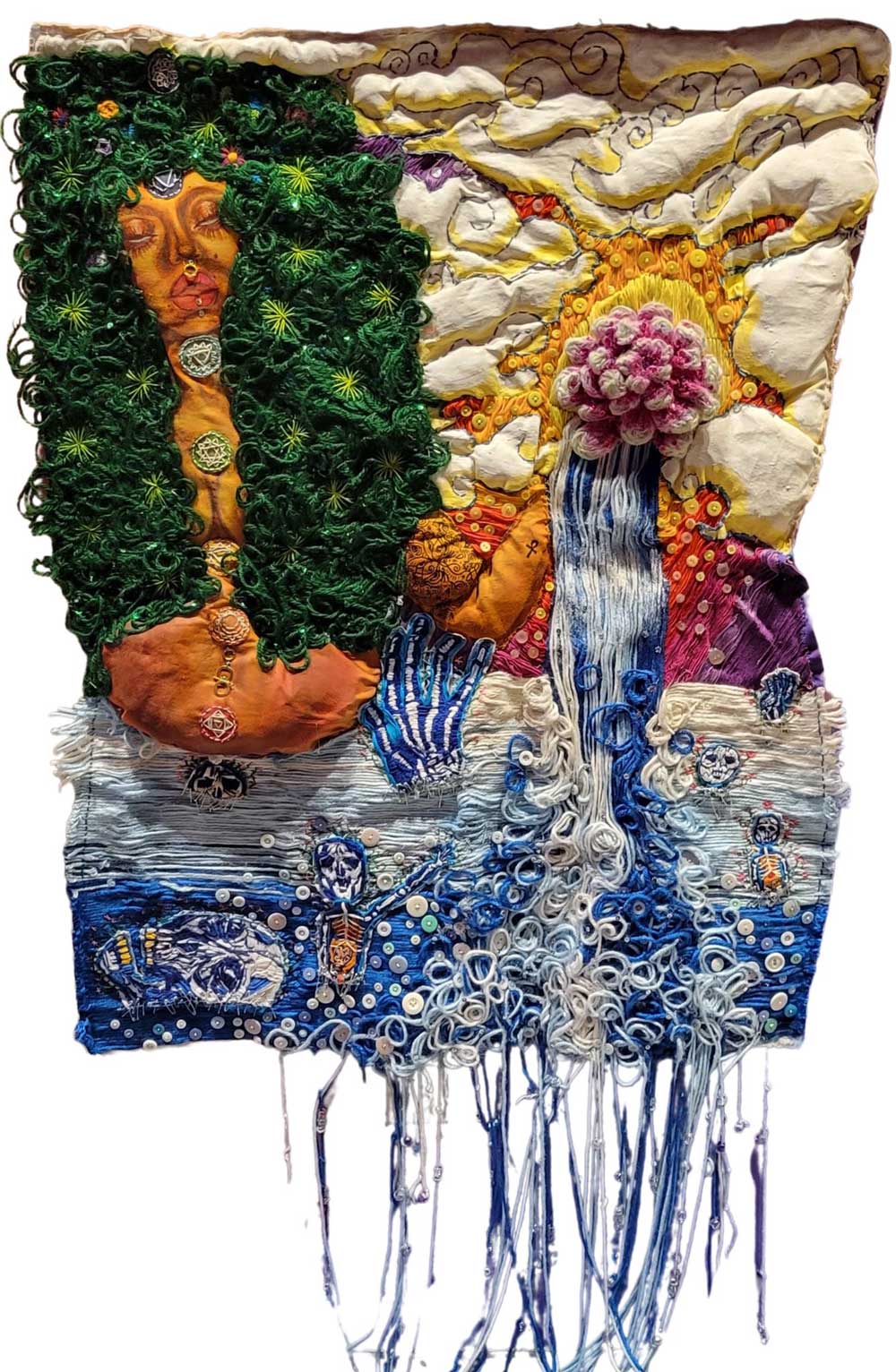

Touching Grass

Height: 42" x Width: 36" x Depth: 2" | Material(s): Bed sheet, buttons, embroidery thread, safety pin, yarn, sequins, beads, uniform pants, stuffing, jewelry | Process(es): Yarn=texture/3d aspect; buttons=glowing aura; thread=cross-hatching/detail/vibrant color; &bead=waterdrop | Idea(s): How people need to touch grass and be in nature more instead of being on their phones/technology. | Curatorial Note: This piece is a refreshing approach to visual design with its elaborate mosaic of texture and color. The piece keeps our eyes wandering satisfyingly through various sections of woven patchwork and stitching. It’s a true delight for the senses.
Samadhi Jones


Student statement
Student statement
Does your work reference or draw on a contemporary or historical artmaking style, practice, or tradition? If so, please explain.
My art does not reflect any particular known style, but what I believe encompasses the American Black experience throughout my usage of color and emotions.
Please describe the context for how the idea for this artwork originated (was this part of your sustained investigation, an independent project, a class assignment, created during a summer study, etc.).
From a young age, my mother would always say, “You're always on that phone.” After hearing that phrase so much, I started to wonder about the effects of constantly being on my phone and/or technology in general. So through research and experimenting with “touching grass” and decreasing my phone usage, I found myself understanding how the media I was consuming was keeping not only myself but my creativity in a bubble and closed mindset. Which I realized was something I not only suffered from alone, but it affected my community. Therefore, I decided to base my sustained investigation around not being slaves to technology and rising above the programming that comes from digital/social media.

Material(s): Bed sheet, buttons, embroidery thread, safety pin, yarn, sequins, beads, uniform pants, stuffing, jewelry | Process(es): Clouds=clearing mind fog, like depression/anxiety; safety pins=technology taking over lost souls
In what ways did you practice and experiment when developing your sustained investigation?
While developing my sustained investigation, I experimented with using interdisciplinary practices and a variety of materials to create a mixed-media body of work. For example, paint, embroidery, colored pencils, school uniform pants, beads, sequins, and watercolor, etc. I practiced ways of stitching patterns and layering my pieces to create additional texture/richness throughout my investigation that catches the eye.
How did you demonstrate revision in your sustained investigation?
At the beginning of my investigation, the work I originally started with was digital. As I started to think cognitively about revising my work, it felt inauthentic to my practice and my overall message of humanity over technological advancements. Therefore, I decided to use a more hands-on approach to creating my pieces.

Throughout my sustained investigation, I kept exploring the idea of technology taking over not only our world but also our bodies. The idea of transhumanism becoming something we all normalize and nature being the only thing that can save humanity.
Your work was selected in part because it achieved synthesis. Can you explain your intentionality in choosing materials and developing processes to further your ideas?
My intentions throughout my investigation are to inform the uninformed and further unite my community to break the confinements of what we deem as normal from government programming through technology and social media. We’re losing the values of what’s truly important and must protect the world that sustains us. This is why the materials carried throughout my piece reflect the helpful everyday materials that are dismissed.
How did your materials and process(es) choices shape the creation or meaning of your artwork(s)?
The materials I used throughout my sustained investigation are items that I used in my day-to-day life, just like social media and technology. These materials are just as important in my day today but so undermined because it’s deemed as the standard. Examples include school uniform pants, safety pins, buttons, sewing needles, yarn, thread, bedsheets, and cotton (stuffing), all man-made items. This in turn also reflected throughout the process of layering and combining all the materials in my work.
How did your art teacher support your artistic development?

From the moment I took my 2-D Art and Design teacher’s course, Mrs. Espina supported my vision and created a space for me to challenge my thinking soI could create an abundance of well-thought-out work through my creative lens. This in turn has helped me research and inform the consumers of my work through the use of my materials, process making, and concepts to create a message throughout my work that’s much bigger than myself.
What is your advice to other AP Art and Design students?
My advice would be to start with what you know. Stop outsourcing on social media. Build upon the community/world around you because everyone’s perception of this world around them is a unique experience. Once you figure out the world around you through your lens, not through the eyes of the media or someone else’s perspective, you become open-minded and discover yourself, finding problems/issues that not only affect you but your community as well. Use your artwork to create a space to uplift and devote change in conversation to fix those issues within your community, even if it feels like no one is seeing your work. Everything starts small and underrated until it takes off, so continue to create change for the betterment of your community.
Amanda Espina
Art Educator
Suitland High School, District Heights, MD, USA
Teacher statement
Teacher statement
The AP Art and Design course supports inquiry-based personalized learning in the sustained investigation portfolio component. What strategies helped you guide students through inquiry?
To help guide students through inquiry, I begin by showing some of the successful and unique example portfolios on the AP website as well as submissions of my previous students. Then I encourage them to brainstorm questions that reflect their curiosity, passions, or personal experiences. I also suggest exploring ideas through the lens of other fields like science, literature, history, or psychology. This can give depth to their investigation and resonate with various audiences. We engage in group discussions where students share their inquiry questions and initial works and focus on their exploration of the question rather than just the technical execution.
What formative and summative assessments helped guide your students through your AP Art and Design curriculum?
Frequently I hold one-on-one conferences to discuss a student's sustained investigation and provide guidance on next steps. We conduct formal critiques for each completed work, focusing on how effectively they address the inquiry question. I cannot stress enough the use of the official AP Art and Design rubric to assess artwork throughout the year, ensuring students understand the criteria.
What did you learn from working with your student?
From working with a student like Samadhi, I learned the power of perseverance, curiosity, and self-motivation in creative growth. She was always pushing herself to do more, work big, and experiment with new materials. Samadhi's work ethic served as an example to motivate other students to set high standards for themselves. Seeing the way she dove headfirst into the unknown reminded me to celebrate effort and perseverance, even when outcomes are uncertain or challenging. Supporting a student like Samadhi emphasized that my role isn’t just to instruct but to guide and challenge students to explore their fullest potential.
Material(s): Bed sheet, buttons, embroidery thread, safety pin, yarn, sequins, beads, uniform pants, stuffing, jewelry | Process(es): Yarn=texture/3d aspect; buttons=glowing aura; thread=cross-hatching/detail/vibrant color; &bead=waterdrop
Samadhi Jones

